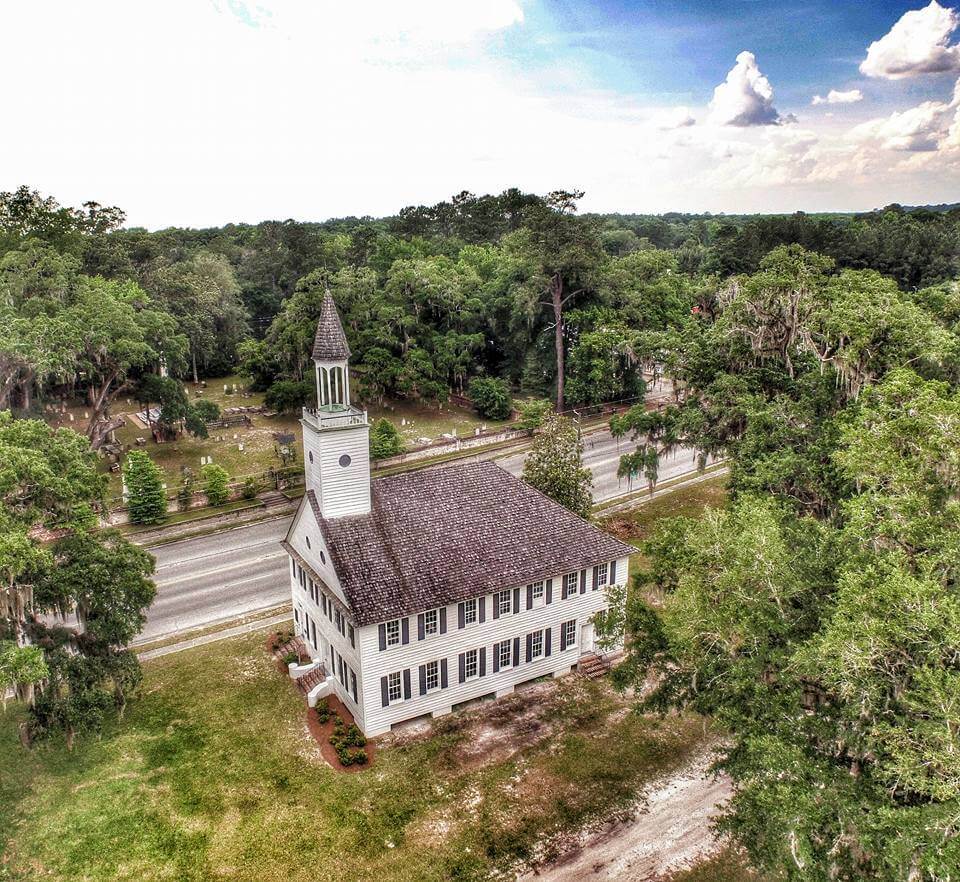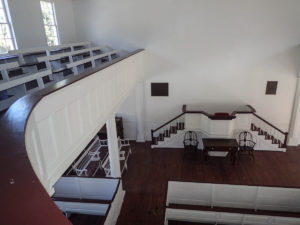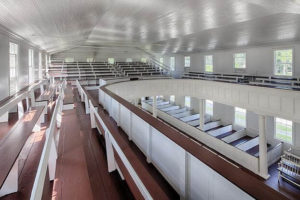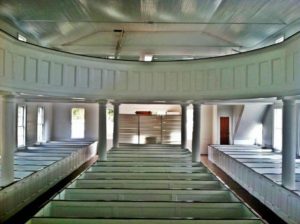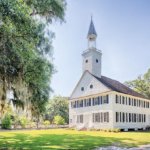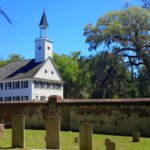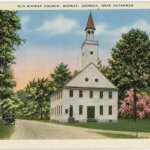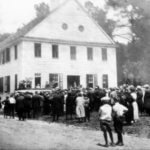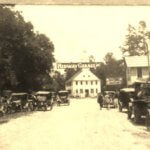Midway Congregational Church & Society
On August 28, 1754, a group of Congregationalists who had migrated from the Northeast to South Carolina, and then to the Midway District of Georgia, established the Midway Society and Church in a log meetinghouse. Congregationalism was a form of Protestantism in which each church is administered autonomously by its members. Despite the Congregationalist nature of the Church, it had strong ties to Presbyterianism. All of its ministers were Presbyterian, and its offshoot churches later became Presbyterian churches.
The first permanent meetinghouse was built in 1756 west of the existing church, and the first service led by Rev. John Osgood on January 2, 1757. This meetinghouse was destroyed by the British during the Revolutionary War.
The church building is seen here with its historic walled cemetery across the widened Highway 17. The Midway Church & Society produced a large number of prominent people, given its small size, and many of these are buried in its almost 2-acre cemetery, including Georgia Governor Nathan Brownson (1742-1796), Senator John Elliott (1773-1827), General Daniel Stewart (1761-1829), and General James Screven (1738-1778).
Left Photo Credit: John Croft. (Click on any photo to enlarge.)
In 1792, the present church building was built in a New England Style. The exterior of the church, now white, was painted red at that time to prevent decay. The church building was reoriented in 1849 to its current placement, and was moved 40 feet east in the 1950’s when Highway 17 was widened. Otherwise, it has never been modernized. It has been described as “one of the most scenic historic landmarks in Georgia.”
Photos: Wayne Moore, Historic Rural Churches of Georgia (hrcga.org)
Visitors are often surprised to hear that it was common in colonial and antebellum times for white members and their African American slaves to attend the same church. The Midway Church has a ‘slave gallery,’ and services for the enslaved people were also held in a building on the Church grounds. In the pictures below – some old and some recent – you will see a central entrance, used for the white people, and a smaller door on the left, used for the slaves to enter the gallery. From its founding until the first Baptist church was established in 1806, the Midway Church was the only church in the area, and thus was not only a place of worship, but a meeting place for all the people of the county, both black and white.
Because the wet, swampy conditions that were perfect for growing rice also were the ideal breeding ground for the mosquitoes who caused malaria and other illnesses, the planters and their families established settlements in the drier pine-forested areas where they would spend the summers. The churches established there were affiliated with the Midway Church, but by the approach of the Civil War, these churches were already in the process of draining membership from the Midway Church. All three — Walthourville Presbyterian Church, Dorchester Presbyterian Church, and Flemington Presbyterian Church — remain in existence today.
In the 1830’s, the Rev. Charles Colcock Jones, a son of an extensive Midway family, began a mission to evangelize the enslaved people of Liberty County’s 15th District plantation owners. Previously there had been black preachers – named Mingo, Jack, and Salter – who had provided services in a location near the Midway Church and at various plantations. Rev. Jones used existing “stations,” set up around the County to enable Midway Church members to avoid the long trek to the Church each Sunday, and other churches, to further his mission. Some of these churches still exist today. The North Newport Baptist Church became the First African Baptist Church, the oldest black church in the County. The Pleasant Grove Church became the Mt. Olivet Methodist Church. The Sunbury Baptist Church evolved into the Sunbury Missionary Baptist Church.
During the Civil War, and especially the occupation of Liberty County by Union troops at the end of 1864, the white Midway Church membership continued to decline rapidly, and their last service was held in 1867 when their pastor left for another assignment. The Midway Society maintained control of the Church building, and leased it to the newly freed African American members, who brought their own minister in and organized the Midway Presbyterian Church in 1868. They continued to maintain the Church and graveyard until 1892, when the congregation moved to what had been a nearby school and then built the Midway First Presbyterian Church, which still stands today a few miles north of the Museum on Highway 17.
Although the Midway Church building has not been used for regular worship services since that time, it has continued to be maintained by the Midway Society, which holds an annual meeting and Homecoming for descendants of antebellum Church members.
The Midway Society kept meticulous records, which have been published as “History and Published Records of the Midway Congregational Church, Liberty County, Georgia, by James Stacy, available in the Midway Museum gift shop along with other hard-to-find books about Liberty County. Two books have also been written about Rev. Charles Colcock Jones — The Children of Pride and The Dwelling Place: A Plantation Epic — and both are also for sale in the gift shop.
